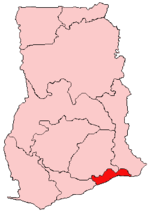Greater Accra Region of Ghana
| Greater Accra Region | ||
|---|---|---|
| Region | ||
|
||
 Location of Greater Accra Region in Ghana |
||
| Country | Ghana | |
| Capital | Accra | |
| Districts | 16 | |
| Government | ||
| • Regional Minister | Ishmael Ashitey | |
| Area | ||
| • Total | 3,245 km2 (1,253 sq mi) | |
| Area rank | Ranked 10th | |
| Population (2010 Census) | ||
| • Total | 4,010,054 | |
| • Rank | Ranked 2nd | |
| • Density | 1,200/km2 (3,200/sq mi) | |
| GDP (PPP) | ||
| • Year | 2013 | |
| • Per capita | $5,150 | |
| GDP (Nominal) | ||
| • Year | 2013 | |
| • Per capita | $2,500 | |
| Time zone | GMT | |
| Area code(s) | 030 | |
| ISO 3166 code | GH-AA | |
The Greater Accra Region has the smallest area of Ghana's 10 administrative regions, occupying a total land surface of 3,245 square kilometres or 1.4 per cent of the total land area of Ghana. It is the second most populated region, after the Ashanti Region, with a population of 4,010,054 in 2010, accounting for 16.3 per cent of Ghana’s total population.
The Greater Accra region is the most urbanized region in the country with 87.4% of its total population living in urban centres.
In 1960, Greater Accra, then referred to as Accra Capital District, was geographically part of the Eastern Region. It was, however, administered separately by the Minister responsible for local government. With effect from 23 July 1982, Greater Accra was created by the Greater Accra Region Law (PNDCL 26) as a legally separate region.
The Greater Accra Region is bordered on the north by the Eastern Region, on the east by the Volta Region, on the south by the Gulf of Guinea, and on the west by the Central Region. It is smallest region of Ghana in total area, and is made up of 16 administrative areas.
The Ga people celebrate the Homowo festival, which literally means "hooting at hunger." This festival originated several centuries ago. It is celebrated in remembrance of a great famine that hit the Ga people in the sixteenth century. It is mainly a food festival which celebrates the passing of that terrible period in Ga history. It takes place in August every year and is celebrated by all the Ga clans.
The Adangbe people from Ada celebrate the Asafotu festival, which is also called 'Asafotufiam', an annual warrior's festival celebrated by Ada people from the last Thursday of July to the first weekend of August commemorates the victories of the warriors in battle and is a memorial for those who fell on the battlefield. To re-enact these historic events, the warriors dress in traditional battle dress and stage a mock battle. This is also a time for male rites of passage, when young men are introduced to warfare. The festival also coincides with the harvest cycle, when these special customs and ceremonies are performed. These include purification ceremonies. The celebration reaches its climax with a durbar of chiefs, a colourful procession of the Chiefs in palanquins with their retinue. They are accompanied by traditional military groups called 'Asafo Companies' amidst drumming, singing and dancing through the streets and on the durbar grounds. At the durbar, greetings are exchanged between the chiefs, libations are poured and declarations of allegiance are made.
...
Wikipedia

